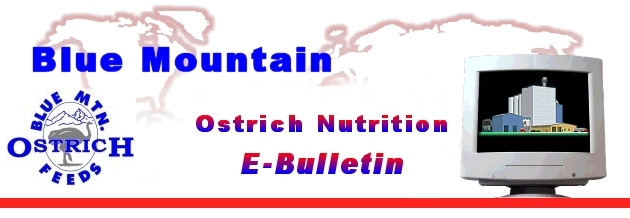
February 5, 2006
Bulletin #100
Table of contents:
Bulletin #100
"Benchmark Production Targets for Ostrich"
By: Daryl Holle, Blue Mountain Feeds
Bulletin #100
Benchmark Production Targets for Ostrich
Blue Mountain Ostrich Nutrition Bulletins were first started by Daryl Holle in December 1996 to develop communication and share information. This Bulletin is Bulletin No. 100, a significant milestone. Over the years Daryl Holle has spent many, many hours writing these and making the information freely available to the industry.
The subject matter of this bulletin is benchmarking production targets for Ostrich. The World Ostrich Association has recently published a range of production targets for Ostrich:
www.world-ostrich.org/targets.htm
Blue Mountain first published benchmark figures in 1997 with the report on the Benchmark weight gain trials. That report and a number of other benchmark trials, studies and comparisons can be viewed from:
www.blue-mountain.net/research.htm
WHAT IS BENCHMARKING?
A benchmark is a standard by which something can be measured or judged. Benchmarking is the process of determining who is the very best, who sets the standard and what that standard is.
Benchmarking is a management tool used by many businesses to measure their performance against the standards or other businesses. In the case of agriculture, performance is measured against other producers.
This is one reason why maintaining good records is essential in agriculture. Monitoring methods and costs, benchmarking helps farmers to have a greater understanding of their production systems and how one or two changes can
make a significant difference to their bottom line.
To help UK red meat producers become more competitive with the recent changes in farm subsidies, the Red Meat Industry Forum has set up a benchmarking scheme. A quote for the discussion on the benefits to those
producers:
Quote: One issue is very clear. The meat industry will no longer be able to afford to produce over 50% of its product outside market conformation and fat class, or 20% outside the target weight range. By using this free benchmarking system, we can help producers understand just how crucial this is to profitability. End quote
There is a very good reason that increased supply of the food on the market is coming from a decreasing number of suppliers, who are growing progressively larger. That reason is not confined to the fact that the major buyers require large scale producers. The reason is that they are the suppliers (producers/processors) who recognise the current market needs.
They also operate to a high degree of precision with high standards of management.
That fact became very clear to me the very first time I entered an ostrich abattoir. An excellent abattoir working to get the very best product they could to the market - but they had no control over the birds offered for slaughter. They had to do the best with what they were presented with. Quality control starts on the farm.
BENCHMARKING FOR OSTRICH
Benchmarking is a method of understanding the norms as achievable targets, but more importantly understanding that they are targets to be improved on. Agricultural production has survived the ongoing price/cost squeeze by continually improving production to reduce the unit costs of production. eg. For breeder birds - cost per chick; for slaughter birds - cost per kilo
of meat.
Benchmarking records production statistics produced under commercial conditions to help commercial producers have something to measure their performance, analyse their performance against measurable criteria and work to improve their performance. If they are not achieving the right performance levels, start asking questions as to why.
Not only are the benchmark targets that have been set very achievable, they are essential for Ostrich production to become commercially viable. You can view the Benchmark Production Targets for Ostrich at the World Ostrich Association website:
www.world-ostrich.org/targets.htm
The End
Click to return to Contents Page
Blue Mountain Ostrich Nutrition E-Bulletin ©February 2006
Copyright© of Blue Mountain all rights reserved
Thanks for visiting BM Ostrich Nutrition E-Bulletins

